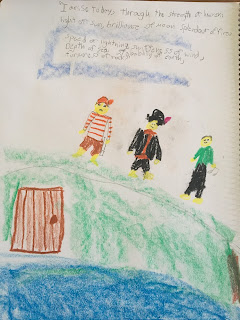I think one of the biggest questions I had before I started homeschooling, and one of the most frequent questions I am now asked, is how a typical day looks. The short answer is that it can vary. Wildly. Flexibility is one of the great things about homeschooling and we exercise that flexibility to learn and have fun often! However, my kids thrive when they have some structure to their day. That's why we have a rhythm, even though we do not have a schedule. I have times listed here, but we really only focus on the activities and never stop them or drag them out to fit a time slot. This is more about the order of events that the kids have come to expect.
I often refer to myself as a "cheater homeschool mom" because I send my little one to preschool. He's three and goes three mornings a week and loves it. He goes to the same school that his older brothers thrived at and I knew keeping him there would give me a few precious hours to devote to teaching the big boys without any distractions. So far it has worked great.
Here's what an average week looks like at Lyons Academy:
 |
| Baking brothers |
Monday:
8-9 Breakfast, dress, maybe some baking
9 - Drive Sean to preschool (the boys do reading from their Brave Writer selections while I drive and drop off)
9:30 - Morning Time - we start by lighting a candle, setting an intention or hearing a prayer or poem and reading a book (
Here's a list of some favorite picture books) and then moving on to
Waldorf Essentials Main Lessons. Main lessons always start with form drawing on Mondays.
11 - recess/walk/snack
11:30 - Brave Writer
Arrow &
Quiver of Arrows copywork passage
12:15- Lunch
12:40 - Pickup Sean, more reading or an audio book in the car
1 - Free time to play
2 - Read aloud from our
Early American History book and drawing/painting to go with it
2:30 - Independent time to practice piano, read, journal, use the Duolingo app for Spanish
 |
| Art class |
Tuesday:
8-9 Breakfast, dress, outdoor play
9 - quick morning time with story book or read aloud.
9:30 Mom to Yoga class and boys to my Mother-in-Law's for cursive writing lesson
11 - Back home for snack and recess
11:30 - Main Lessons from WE
12:30 - Lunch
1:30 - Art class (we use various classes on CreativeBug, currently Lisa Congdon's Boot Camp)
2 Narrating from our previous day Early American History book read aloud
2:30 - Independent time for copywork (any non-fiction passage they choose), piano practice, Duolingo Spanish
 |
| Main Lesson - Math Block, Grade 4 |
Wednesday:
8-9 - Breakfast, dress, outdoor play
9 - Drive Sean to school/reading time in car
9:30 - Morning Time with Main Lessons
10:30 - Piano Lessons - each boy has a half hour lesson with an instructor who comes to our home while I work with the brother on their Arrow copywork passage for the week (learning parts of speech, spelling, language mechanics
11;30 - Recess/lunch/free time (the boys are worn out from a busy morning so we relax a little!)
12:40 - Pickup Sean, more reading or an audio book in the car
1 - Read aloud from our
Early American History book and drawing/painting to go with it
1:30 Creative Writing/Shakespeare
2 - Independent time to read, journal, handwork and use the Duolingo app for Spanish
 |
| Ant study from Abundant Garden |
Thursday:
8-9 Breakfast/dress
9- Drive to Homeschool Gymnastics at the Harris YMCA/boys read
9:30-11:30 Gymnastics/Sean and I run at the track, play on the playground and grocery shop
Often the boys go home from gymnastics with my Mother-in-law for knitting and write their previous days' narration there, if not we come home and eat lunch and do it
1 -
Abundant Garden Science Lesson
2 - Narration from previous days' Early American History lesson
 |
| Poetry Teatime |
Friday:
8-9 Breakfast, dress, maybe some baking
9 - Drive Sean to preschool (the boys do reading from their Brave Writer selections while I drive and drop off)
9:30 - Morning Time - we start by lighting a candle, setting an intention or hearing a prayer or poem and reading a book (
Here's a list of some favorite picture books) and then moving on to
Waldorf Essentials Main Lessons
11 - recess/walk/snack
11:30 - Brave Writer
Arrow &
Quiver of Arrows copywork passage spelling/grammar test
12:15- Lunch
12:40 - Pickup Sean, more reading or an audio book in the car
1 - Free time to play, practice piano, read
2 -
Poetry Teatime
WHEW! So, that would be if we had no field trips or special activities in a week. If we do, we still always try to get in four main lesson blocks, a lot of reading and our literacy work with Brave Writer. History, art, copywork and science get shuffled around as needed, not because I don't think they are important, just that we do cover those areas in main lessons a bit too.
If you ask my boys they would probably say the week goes like this:
Monday - Form Drawing
Tuesday - Cursive (or field trips)
Wednesday - Piano
Thursday - Gymnastics
Friday - Poetry Teatime
Those are the highlights for sure!







































